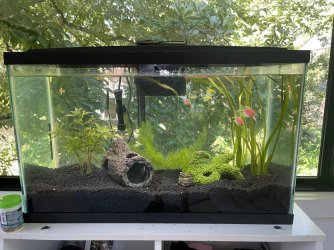Hi There -
Brand new to fishkeeping and have read a lot online. So I think I know where I went wrong, but need to confirm before I make the same mistake again.
We started fishkeeping last spring when my daughter’s 1st grade teacher asked us to keep the classroom goldfish over the summer. The experience was great and we learned a lot (and successfully kept the goldfish alive!). Now that school is back, we wanted to take the next step…Here’s what we did:
- purchased a new 29 gallon tank with substrate and live plants
- purchased 10 glofish tetras from local petco
- set up the new tank and added the glofish the same day ALONG WITH API Quick Start that “allows instant addition of fish”. Why did we do this? Because our 7 year old (and me) couldn’t wait and we’re too excited to have new fish in our new aquarium.
- 1 week later, purchased 1 dwarf gourami from a locally owned tropical aquarium store and added him.
- 3 weeks later, we’ve lost 4 fish, including the DG.
We could tell something was wrong with what looked like fin rot and that cotton-looking fungal infection creeping in. Within 2 days of noticing that, the fish are dropping.
I know we didn’t cycle the tank properly, but we’ve been testing and the amonia, nitrate, and nitrite levels are all at or near zero. I’m not even sure where we are within the cycle.
Please help. My daughter is devastated. We assume we’ll lose the rest of the fish. And if so, we will want to try again. What should we do?
Brand new to fishkeeping and have read a lot online. So I think I know where I went wrong, but need to confirm before I make the same mistake again.
We started fishkeeping last spring when my daughter’s 1st grade teacher asked us to keep the classroom goldfish over the summer. The experience was great and we learned a lot (and successfully kept the goldfish alive!). Now that school is back, we wanted to take the next step…Here’s what we did:
- purchased a new 29 gallon tank with substrate and live plants
- purchased 10 glofish tetras from local petco
- set up the new tank and added the glofish the same day ALONG WITH API Quick Start that “allows instant addition of fish”. Why did we do this? Because our 7 year old (and me) couldn’t wait and we’re too excited to have new fish in our new aquarium.
- 1 week later, purchased 1 dwarf gourami from a locally owned tropical aquarium store and added him.
- 3 weeks later, we’ve lost 4 fish, including the DG.
We could tell something was wrong with what looked like fin rot and that cotton-looking fungal infection creeping in. Within 2 days of noticing that, the fish are dropping.
I know we didn’t cycle the tank properly, but we’ve been testing and the amonia, nitrate, and nitrite levels are all at or near zero. I’m not even sure where we are within the cycle.
Please help. My daughter is devastated. We assume we’ll lose the rest of the fish. And if so, we will want to try again. What should we do?



